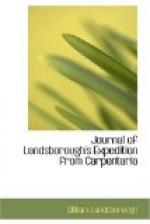Started this morning at 10.20; at 3.20 p.m. reached the place I had chosen yesterday for our encampment and unsaddled. Gleeson had so much recovered that he did not complain of fatigue during the day’s journey. Distance today fourteen miles.
March 23.
As this was Sunday we rested ourselves and horses. Gleeson and Jemmy still unwell; the former very weak and complaining of want of appetite and sleep.
March 24.
Today we followed the creek down for about fifteen miles and three-quarters and encamped at a fine waterhole. All along the creek there are fine deep waterholes. The channel is a kind of sandstone formation, particularly good for retaining water. About eight miles above here the creek is joined by another watercourse, about the same size, from the north-west. I have named it Coxen Creek. The country is not so level as it is higher up the creek. The soil is very good with grass, saltbush, and herbs. Sheep or cattle will do well on it but it will not carry much stock to its acreage as it is confined at many places by ridges with triodia and only a small proportion of other grasses. Triodia is certainly better than nothing, as stock will eat it when it is young, and at other times will eat it rather than starve. The best part of the country is thickly wooded with acacia and other small trees. This would not be objectionable where blacks were quiet and where it is not necessary at times to run sheep in large flocks; but in the first occupation of the country it will be so, as labour will probably be scarce. We travelled today at our usual pace from 8.27 a.m. to 1.55 p.m. Gleeson was so much recovered that he did not complain of fatigue. We came here on the following courses: 9.27 south-east for two and three-quarter miles; 11.10 south-south-east five miles to the junction of Coxen Creek; 1.55 south-south-east eight miles.
March 25.
Started at 8.15 this morning. Came down the right bank of the creek for about fifteen miles and encamped at 2.53. The creek has fine deep holes of water. The channel generally is confined by sandstone at places by shelving rocks a few feet high and inaccessible for horses. Here the channel is broad and sandy; about seven miles below the last camp it is joined by a smaller watercourse from the north-west named by me Raff Creek. The country we saw from our path was mostly good. It consists of well-grassed, thinly-wooded flats, separated from each other by belts of Port Curtis sandalwood, bauhinia, and other small trees, and at other places by low ridges with triodia. The country in the immediate neighbourhood consists of low ridges of poor soil with numerous rocky gullies. These ridges are chiefly wooded with ironbak and grassed with triodia. We traversed down the creek in the following way: 9.25 south-south-east three and a quarter miles; 11.4 south two and three-quarter miles to Raff Creek; 1.30 south five and three-quarter miles; 2.10 south-east and by south one and a quarter miles to a small creek from the north-west; 3.54 south two miles to here.




